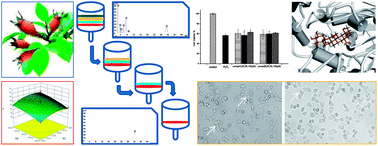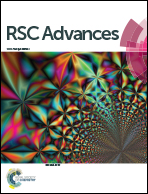Extraction and isolation of polyhydroxy triterpenoids from Rosa laevigata Michx. fruit with anti-acetylcholinesterase and neuroprotection properties†
Abstract
Rosa laevigata fruit, at present, is becoming increasingly popular as a functional foodstuff with several nutritional and medicinal properties. To explore the acetylcholinesterase (AChE) inhibitory activity of extracts from the Rosa laevigata Michx. fruit (RLMF), a simple and efficient enrichment purification technology based on microwave-assisted extraction (MAE) and multi vacuum extraction columns (VEC) was applied to screen and identify triterpenoids (TTs) in the RLMF extracts. The MAE conditions were optimized using the Box–Behnken design (BBD) with a quadratic regression model and the response surface method (RSM). The optimum conditions were as follows: ethanol concentration, 69%; extraction time, 12 min; ratio of liquid to raw material, 26 : 1 mL g−1; and microwave power, 528 W. Under these conditions, the maximum content of triterpenoids reached 62.48 ± 0.25 mg g−1, which was close to the predicted value of 62.69 mg g−1. In addition, two pure polyhydroxy triterpenoids: 2α,3β,19α,23-tetrahydroxyurs-12-en-28-oic acid (1) and 2α,3β,19α,23-tetrahydroxyurs-12-en-28-oic acid-28-O-β-D-glucopyrannoside (2) were isolated and enriched to more than 500 mg by a multi VEC method. Furthermore, the quantities of compounds 1 and 2 from RLMF were 5.36 and 10.37 mg g−1, respectively, as determined using HPLC. These compounds were further assessed for acetylcholinesterase inhibitory and neuroprotection properties. The results showed that 1 and 2 showed potent AChE inhibitory activities with IC50 values of 29.22 and 45.47 μg mL−1, respectively. At high concentration, compounds 1 and 2 produced a 92% and 89% inhibition on the target enzyme, which was consistent with docking results between AChE and each isolate. Moreover, both 1 and 2 exhibited potential neuroprotective activities against H2O2-induced SHSY5Y cell death.



 Please wait while we load your content...
Please wait while we load your content...